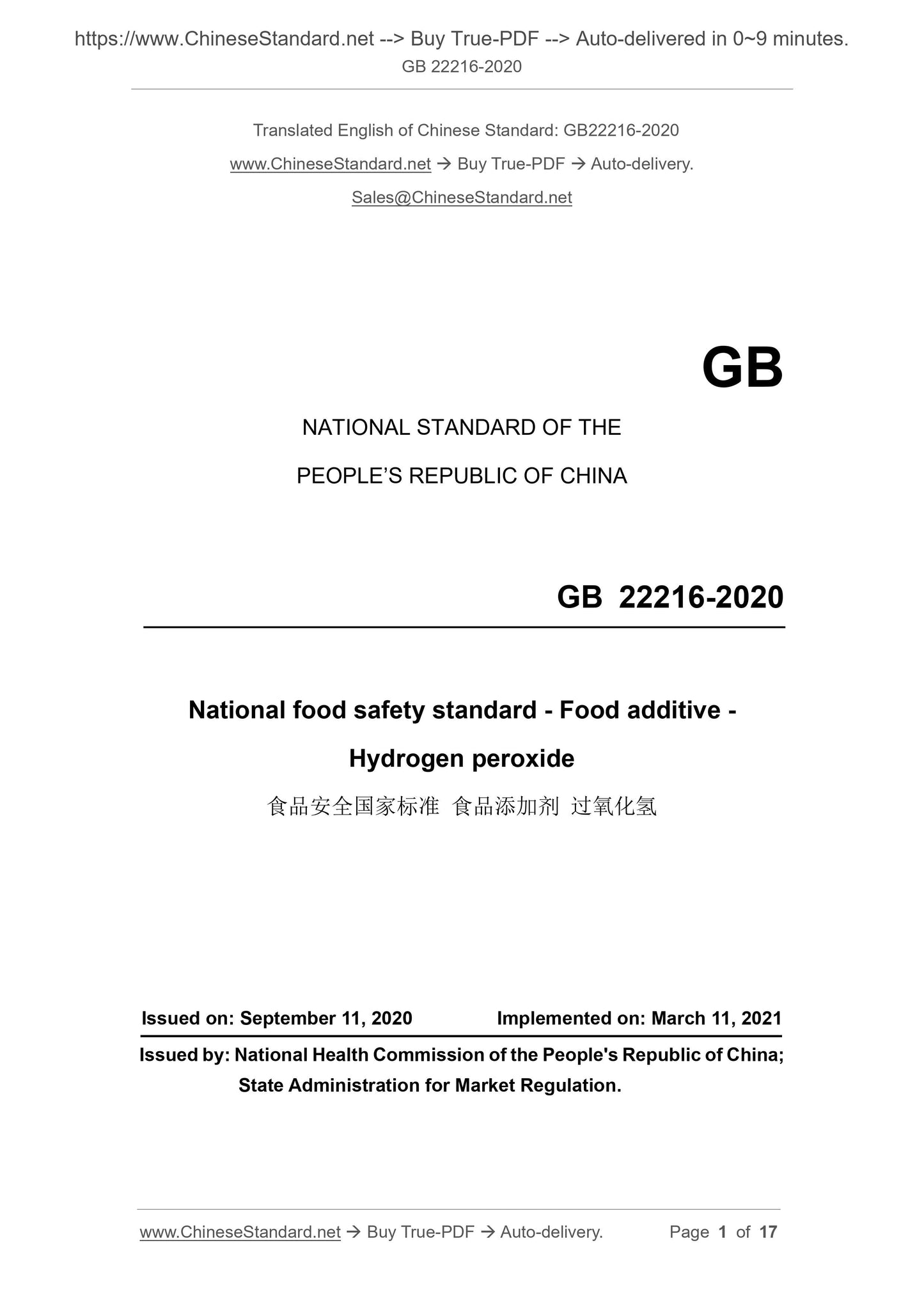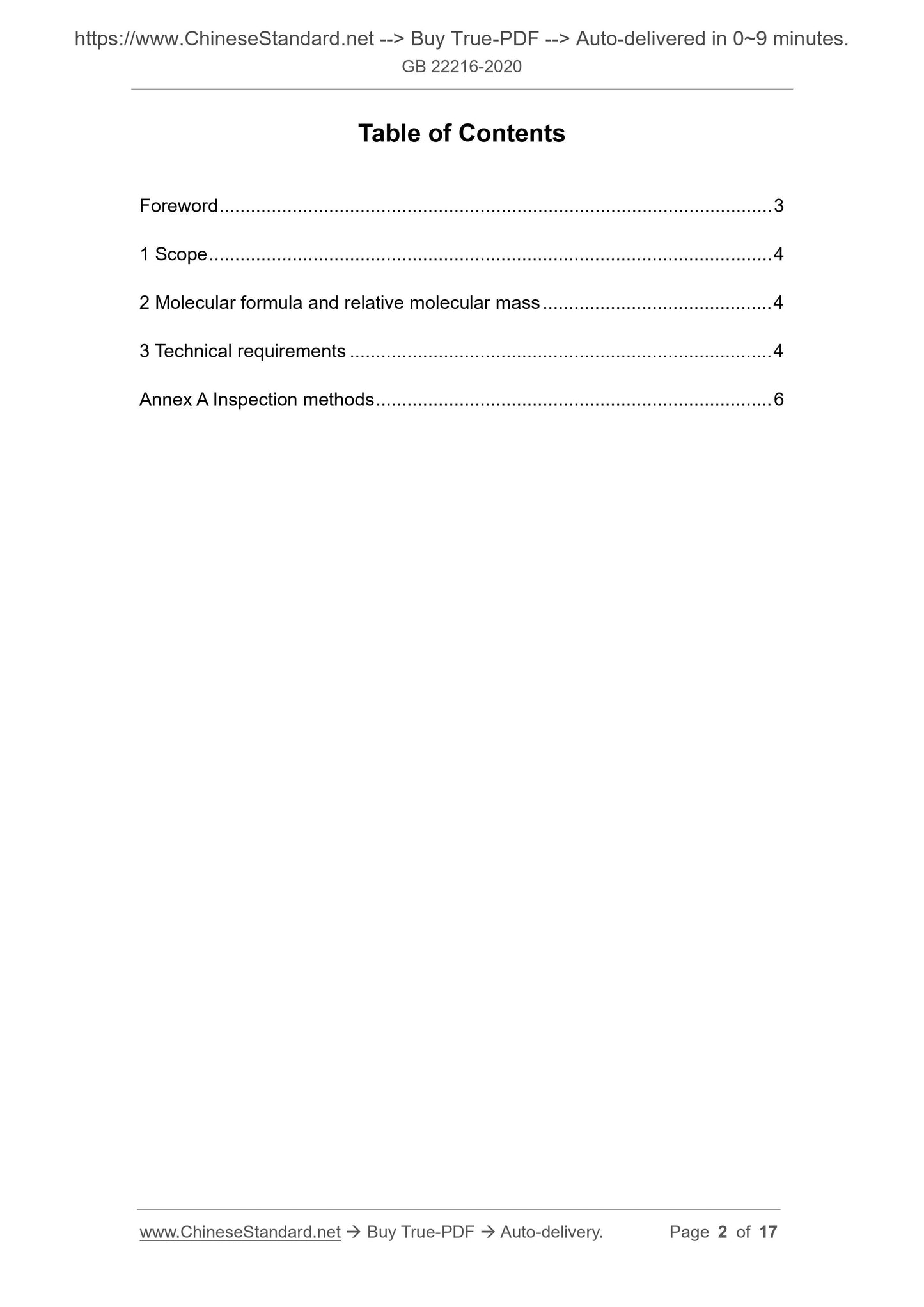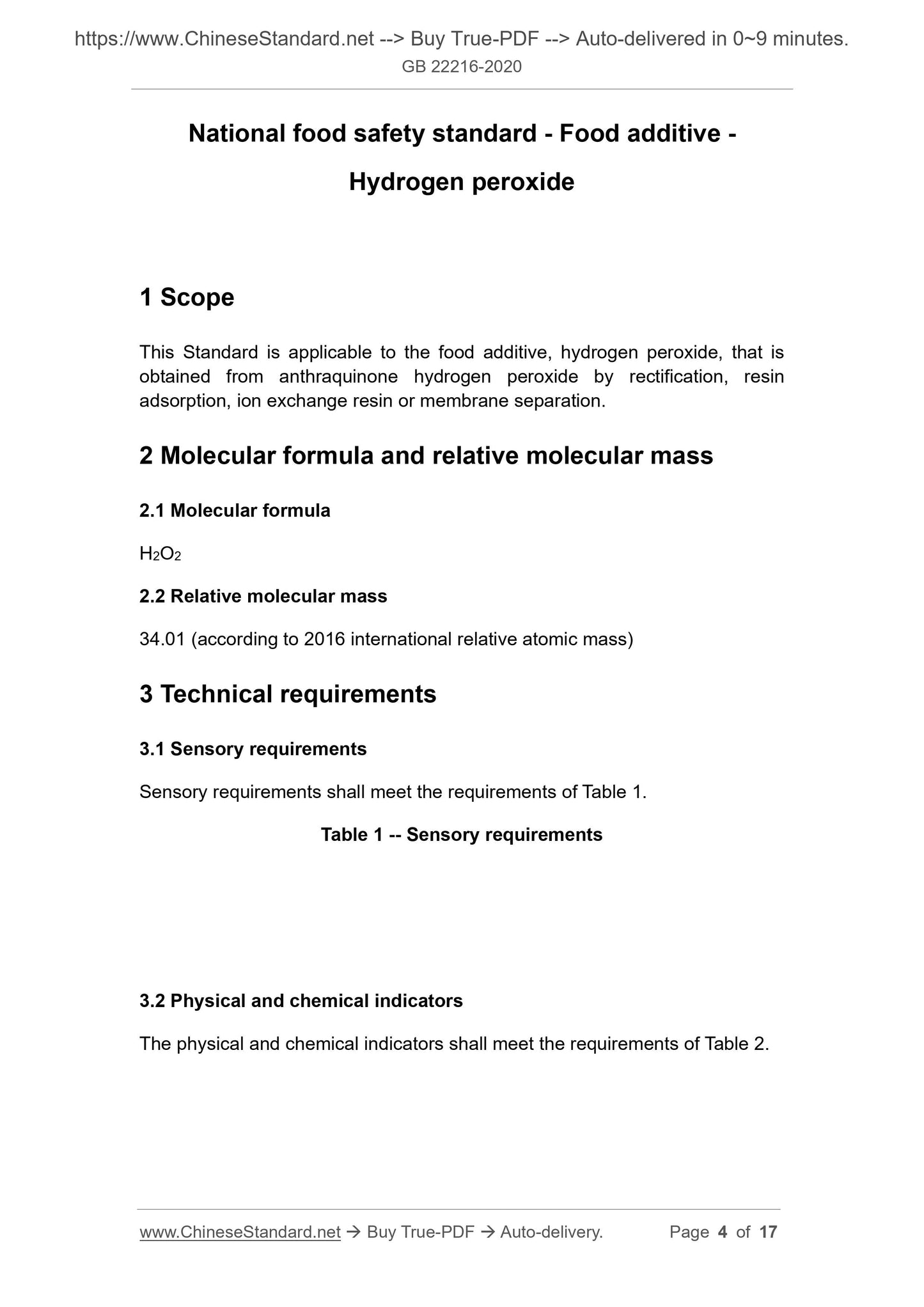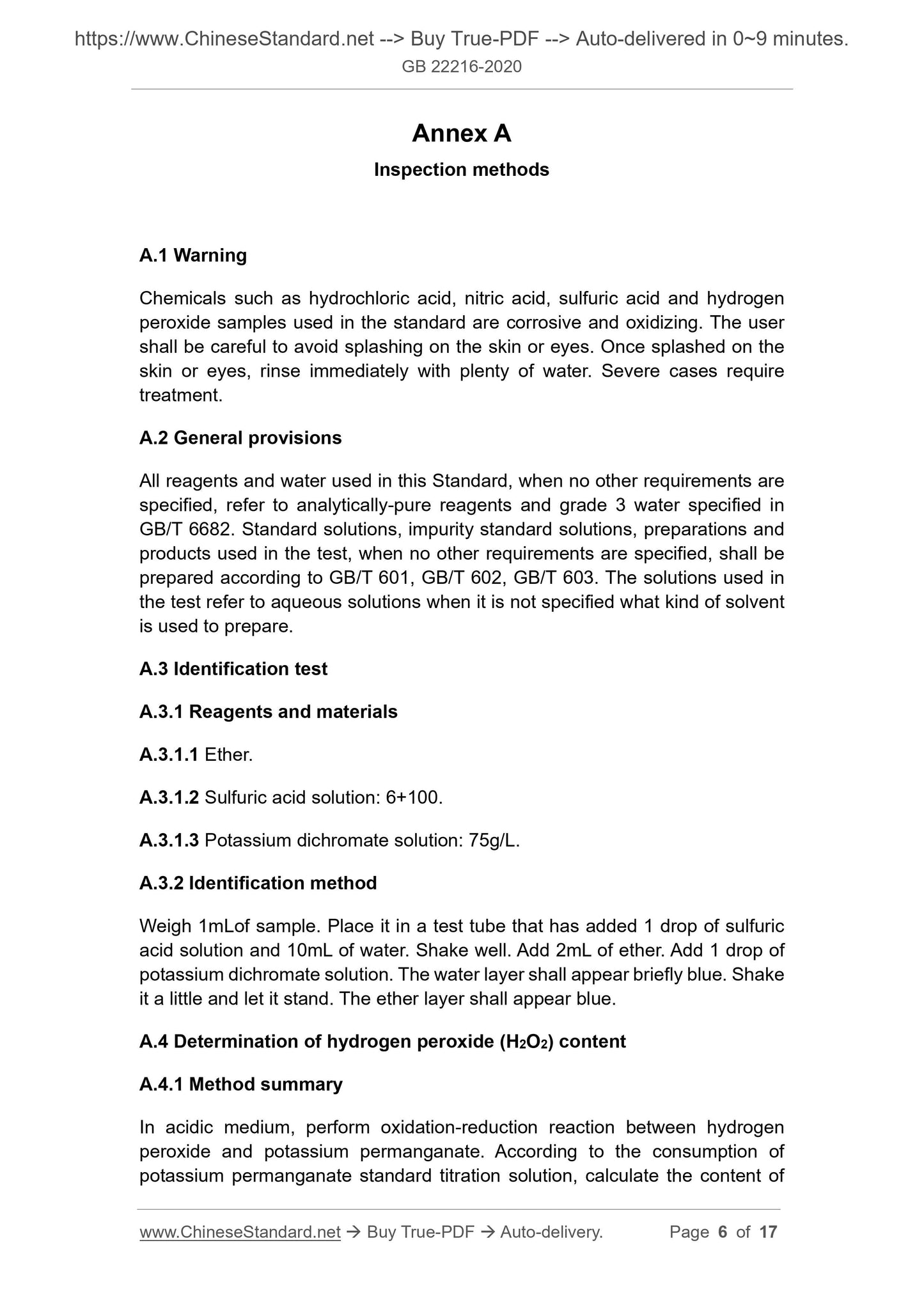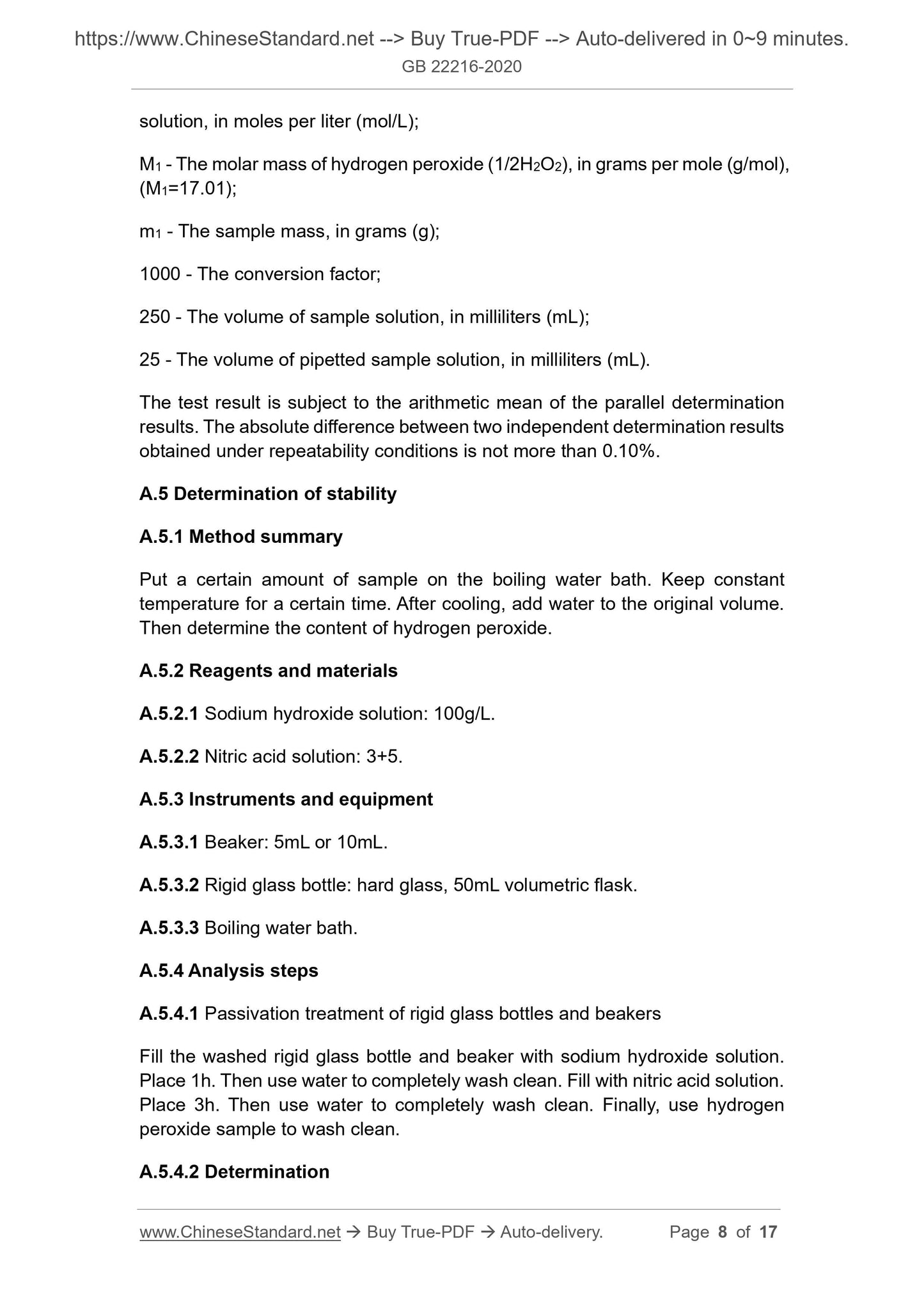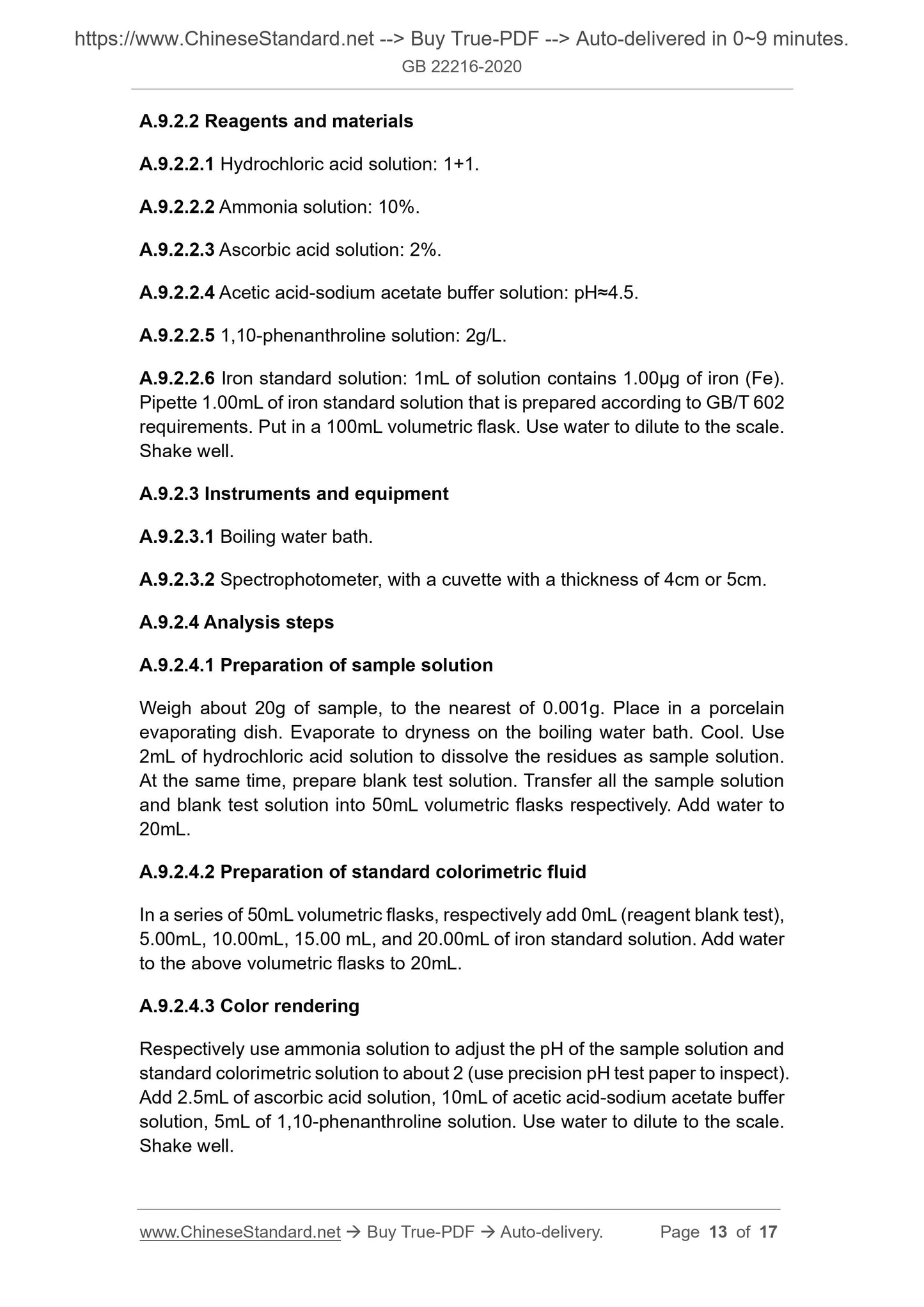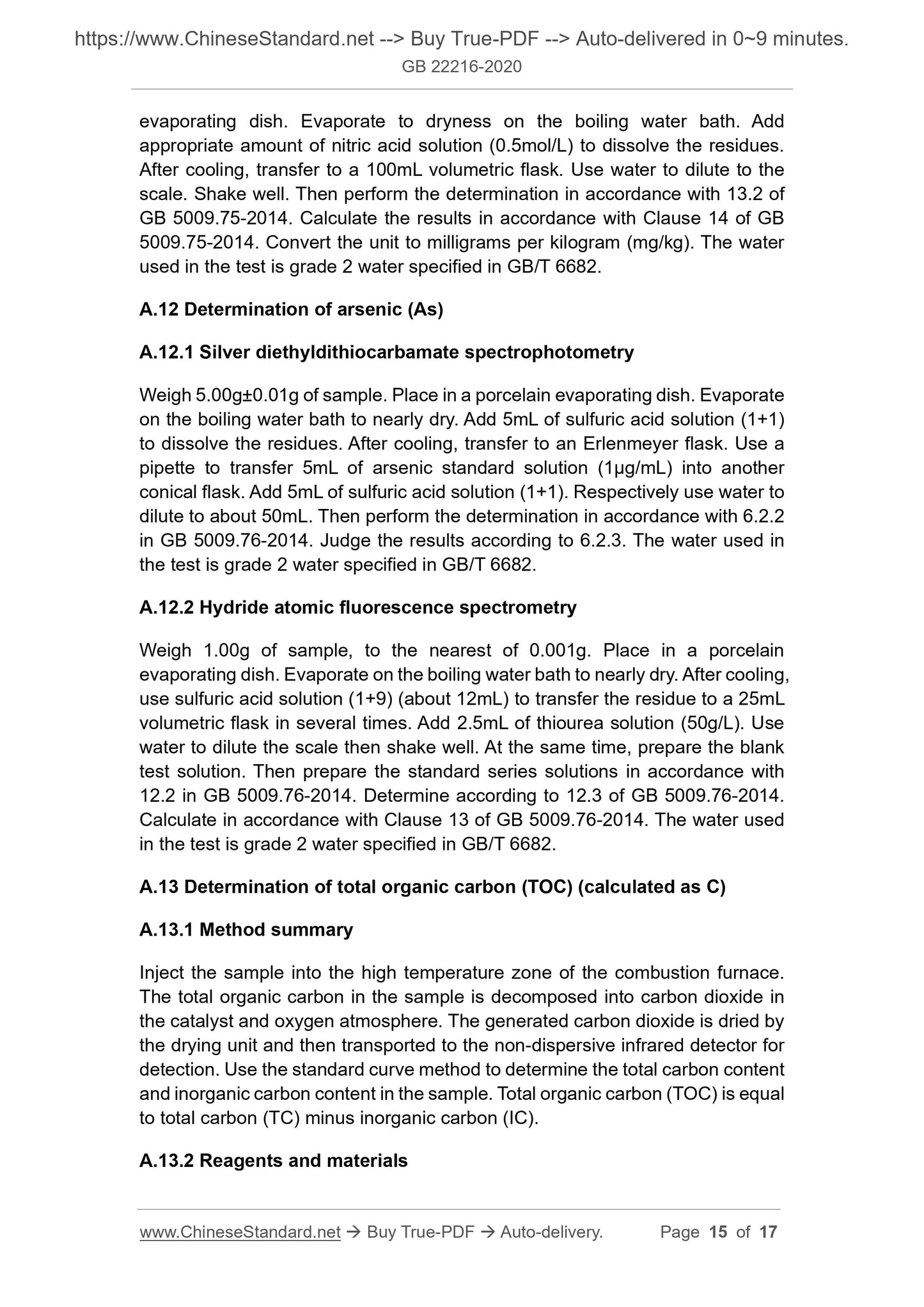1
/
of
7
PayPal, credit cards. Download editable-PDF & invoice in 1 second!
GB 22216-2020 English PDF
GB 22216-2020 English PDF
Regular price
$185.00 USD
Regular price
Sale price
$185.00 USD
Unit price
/
per
Shipping calculated at checkout.
Couldn't load pickup availability
Delivery: 3 seconds. Download true-PDF + Invoice.
Get QUOTATION in 1-minute: Click GB 22216-2020
Historical versions: GB 22216-2020
Preview True-PDF (Reload/Scroll if blank)
GB 22216-2020: National food safety standard - Food additive - Hydrogen peroxide
GB 22216-2020
GB
NATIONAL STANDARD OF THE
PEOPLE’S REPUBLIC OF CHINA
National food safety standard - Food additive -
Hydrogen peroxide
ISSUED ON: SEPTEMBER 11, 2020
IMPLEMENTED ON: MARCH 11, 2021
Issued by: National Health Commission of the People's Republic of China;
State Administration for Market Regulation.
Table of Contents
Foreword ... 3
1 Scope ... 4
2 Molecular formula and relative molecular mass ... 4
3 Technical requirements ... 4
Annex A Inspection methods ... 6
National food safety standard - Food additive -
Hydrogen peroxide
1 Scope
This Standard is applicable to the food additive, hydrogen peroxide, that is
obtained from anthraquinone hydrogen peroxide by rectification, resin
adsorption, ion exchange resin or membrane separation.
2 Molecular formula and relative molecular mass
2.1 Molecular formula
H2O2
2.2 Relative molecular mass
34.01 (according to 2016 international relative atomic mass)
3 Technical requirements
3.1 Sensory requirements
Sensory requirements shall meet the requirements of Table 1.
Table 1 -- Sensory requirements
3.2 Physical and chemical indicators
The physical and chemical indicators shall meet the requirements of Table 2.
Annex A
Inspection methods
A.1 Warning
Chemicals such as hydrochloric acid, nitric acid, sulfuric acid and hydrogen
peroxide samples used in the standard are corrosive and oxidizing. The user
shall be careful to avoid splashing on the skin or eyes. Once splashed on the
skin or eyes, rinse immediately with plenty of water. Severe cases require
treatment.
A.2 General provisions
All reagents and water used in this Standard, when no other requirements are
specified, refer to analytically-pure reagents and grade 3 water specified in
GB/T 6682. Standard solutions, impurity standard solutions, preparations and
products used in the test, when no other requirements are specified, shall be
prepared according to GB/T 601, GB/T 602, GB/T 603. The solutions used in
the test refer to aqueous solutions when it is not specified what kind of solvent
is used to prepare.
A.3 Identification test
A.3.1 Reagents and materials
A.3.1.1 Ether.
A.3.1.2 Sulfuric acid solution: 6+100.
A.3.1.3 Potassium dichromate solution: 75g/L.
A.3.2 Identification method
Weigh 1mLof sample. Place it in a test tube that has added 1 drop of sulfuric
acid solution and 10mL of water. Shake well. Add 2mL of ether. Add 1 drop of
potassium dichromate solution. The water layer shall appear briefly blue. Shake
it a little and let it stand. The ether layer shall appear blue.
A.4 Determination of hydrogen peroxide (H2O2) content
A.4.1 Method summary
In acidic medium, perform oxidation-reduction reaction between hydrogen
peroxide and potassium permanganate. According to the consumption of
potassium permanganate standard titration solution, calculate the content of
solution, in moles per liter (mol/L);
M1 - The molar mass of hydrogen peroxide (1/2H2O2), in grams per mole (g/mol),
(M1=17.01);
m1 - The sample mass, in grams (g);
1000 - The conversion factor;
250 - The volume of sample solution, in milliliters (mL);
25 - The volume of pipetted sample solution, in milliliters (mL).
The test result is subject to the arithmetic mean of the parallel determination
results. The absolute difference between two independent determination results
obtained under repeatability conditions is not more than 0.10%.
A.5 Determination of stability
A.5.1 Method summary
Put a certain amount of sample on the boiling water bath. Keep constant
temperature for a certain time. After cooling, add water to the original volume.
Then determine the content of hydrogen peroxide.
A.5.2 Reagents and materials
A.5.2.1 Sodium hydroxide solution: 100g/L.
A.5.2.2 Nitric acid solution: 3+5.
A.5.3 Instruments and equipment
A.5.3.1 Beaker: 5mL or 10mL.
A.5.3.2 Rigid glass bottle: hard glass, 50mL volumetric flask.
A.5.3.3 Boiling water bath.
A.5.4 Analysis steps
A.5.4.1 Passivation treatment of rigid glass bottles and beakers
Fill the washed rigid glass bottle and beaker with sodium hydroxide solution.
Place 1h. Then use water to completely wash clean. Fill with nitric acid solution.
Place 3h. Then use water to completely wash clean. Finally, use hydrogen
peroxide sample to wash clean.
A.5.4.2 Determination
A.9.2.2 Reagents and materials
A.9.2.2.1 Hydrochloric acid solution: 1+1.
A.9.2.2.2 Ammonia solution: 10%.
A.9.2.2.3 Ascorbic acid solution: 2%.
A.9.2.2.4 Acetic acid-sodium acetate buffer solution: pH≈4.5.
A.9.2.2.5 1,10-phenanthroline solution: 2g/L.
A.9.2.2.6 Iron standard solution: 1mL of solution contains 1.00μg of iron (Fe).
Pipette 1.00mL of iron standard solution that is prepared according to GB/T 602
requirements. Put in a 100mL volumetric flask. Use water to dilute to the scale.
Shake well.
A.9.2.3 Instruments and equipment
A.9.2.3.1 Boiling water bath.
A.9.2.3.2 Spectrophotometer, with a cuvette with a thickness of 4cm or 5cm.
A.9.2.4 Analysis steps
A.9.2.4.1 Preparation of sample solution
Weigh about 20g of sample, to the nearest of 0.001g. Place in a porcelain
evaporating dish. Evaporate to dryness on the boiling water bath. Cool. Use
2mL of hydrochloric acid solution to dissolve the residues as sample solution.
At the same time, prepare blank test solution. Transfer all the sample solution
and blank test solution into 50mL volumetric flasks respectively. Add water to
20mL.
A.9.2.4.2 Preparation of standard colorimetric fluid
In a series of 50mL volumetric flasks, respectively add 0mL (reagent blank test),
5.00mL, 10.00mL, 15.00 mL, and 20.00mL of iron standard solution. Add water
to the above volumetric flasks to 20mL.
A.9.2.4.3 Color rendering
Respectively use ammonia solution to adjust the pH of the sample solution and
standard colorimetric solution to about 2 (use precision pH test paper to inspect).
Add 2.5mL of ascorbic acid solution, 10mL of acetic acid-sodium acetate buffer
solution, 5mL of 1,10-phenanthroline solution. Use water to dilute to the scale.
Shake well.
evaporating dish. Evaporate to dryness on the boiling water bath. Add
appropriate amount of nitric acid solution (0.5mol/L) to dissolve the residues.
After cooling, transfer to a 100mL volumetric flask. Use water to dilute to the
scale. Shake well. Then perform the determination in accordance with 13.2 of
GB 5009.75-2014. Calculate the results in accordance with Clause 14 of GB
5009.75-2014. Convert the unit to milligrams per kilogram (mg/kg). The water
used in the test is grade 2 water specified in GB/T 6682.
A.12 Determination of arsenic (As)
A.12.1 Silver diethyldithiocarbamate spectrophotometry
Weigh 5.00g±0.01g of sample. Place in a porcelain evaporating dish. Evaporate
on the boiling water bath to nearly dry. Add 5mL of sulfuric acid solution (1+1)
to dissolve the residues. After cooling, transfer to an Erlenmeyer flask. Use a
pipette to transfer 5mL of arsenic standard solution (1μg/mL) into another
conical flask. Add 5mL of sulfuric acid solution (1+1). Respectively use water to
dilute to about 50mL. Then perform the determination in accordance with 6.2.2
in GB 5009.76-2014. Judge the results according to 6.2.3. The water used in
the test is grade 2 water specified in GB/T 6682.
A.12.2 Hydride atomic fluorescence spectrometry
Weigh 1.00g of sample, to the nearest of 0.001g. Place in a porcelain
Get QUOTATION in 1-minute: Click GB 22216-2020
Historical versions: GB 22216-2020
Preview True-PDF (Reload/Scroll if blank)
GB 22216-2020: National food safety standard - Food additive - Hydrogen peroxide
GB 22216-2020
GB
NATIONAL STANDARD OF THE
PEOPLE’S REPUBLIC OF CHINA
National food safety standard - Food additive -
Hydrogen peroxide
ISSUED ON: SEPTEMBER 11, 2020
IMPLEMENTED ON: MARCH 11, 2021
Issued by: National Health Commission of the People's Republic of China;
State Administration for Market Regulation.
Table of Contents
Foreword ... 3
1 Scope ... 4
2 Molecular formula and relative molecular mass ... 4
3 Technical requirements ... 4
Annex A Inspection methods ... 6
National food safety standard - Food additive -
Hydrogen peroxide
1 Scope
This Standard is applicable to the food additive, hydrogen peroxide, that is
obtained from anthraquinone hydrogen peroxide by rectification, resin
adsorption, ion exchange resin or membrane separation.
2 Molecular formula and relative molecular mass
2.1 Molecular formula
H2O2
2.2 Relative molecular mass
34.01 (according to 2016 international relative atomic mass)
3 Technical requirements
3.1 Sensory requirements
Sensory requirements shall meet the requirements of Table 1.
Table 1 -- Sensory requirements
3.2 Physical and chemical indicators
The physical and chemical indicators shall meet the requirements of Table 2.
Annex A
Inspection methods
A.1 Warning
Chemicals such as hydrochloric acid, nitric acid, sulfuric acid and hydrogen
peroxide samples used in the standard are corrosive and oxidizing. The user
shall be careful to avoid splashing on the skin or eyes. Once splashed on the
skin or eyes, rinse immediately with plenty of water. Severe cases require
treatment.
A.2 General provisions
All reagents and water used in this Standard, when no other requirements are
specified, refer to analytically-pure reagents and grade 3 water specified in
GB/T 6682. Standard solutions, impurity standard solutions, preparations and
products used in the test, when no other requirements are specified, shall be
prepared according to GB/T 601, GB/T 602, GB/T 603. The solutions used in
the test refer to aqueous solutions when it is not specified what kind of solvent
is used to prepare.
A.3 Identification test
A.3.1 Reagents and materials
A.3.1.1 Ether.
A.3.1.2 Sulfuric acid solution: 6+100.
A.3.1.3 Potassium dichromate solution: 75g/L.
A.3.2 Identification method
Weigh 1mLof sample. Place it in a test tube that has added 1 drop of sulfuric
acid solution and 10mL of water. Shake well. Add 2mL of ether. Add 1 drop of
potassium dichromate solution. The water layer shall appear briefly blue. Shake
it a little and let it stand. The ether layer shall appear blue.
A.4 Determination of hydrogen peroxide (H2O2) content
A.4.1 Method summary
In acidic medium, perform oxidation-reduction reaction between hydrogen
peroxide and potassium permanganate. According to the consumption of
potassium permanganate standard titration solution, calculate the content of
solution, in moles per liter (mol/L);
M1 - The molar mass of hydrogen peroxide (1/2H2O2), in grams per mole (g/mol),
(M1=17.01);
m1 - The sample mass, in grams (g);
1000 - The conversion factor;
250 - The volume of sample solution, in milliliters (mL);
25 - The volume of pipetted sample solution, in milliliters (mL).
The test result is subject to the arithmetic mean of the parallel determination
results. The absolute difference between two independent determination results
obtained under repeatability conditions is not more than 0.10%.
A.5 Determination of stability
A.5.1 Method summary
Put a certain amount of sample on the boiling water bath. Keep constant
temperature for a certain time. After cooling, add water to the original volume.
Then determine the content of hydrogen peroxide.
A.5.2 Reagents and materials
A.5.2.1 Sodium hydroxide solution: 100g/L.
A.5.2.2 Nitric acid solution: 3+5.
A.5.3 Instruments and equipment
A.5.3.1 Beaker: 5mL or 10mL.
A.5.3.2 Rigid glass bottle: hard glass, 50mL volumetric flask.
A.5.3.3 Boiling water bath.
A.5.4 Analysis steps
A.5.4.1 Passivation treatment of rigid glass bottles and beakers
Fill the washed rigid glass bottle and beaker with sodium hydroxide solution.
Place 1h. Then use water to completely wash clean. Fill with nitric acid solution.
Place 3h. Then use water to completely wash clean. Finally, use hydrogen
peroxide sample to wash clean.
A.5.4.2 Determination
A.9.2.2 Reagents and materials
A.9.2.2.1 Hydrochloric acid solution: 1+1.
A.9.2.2.2 Ammonia solution: 10%.
A.9.2.2.3 Ascorbic acid solution: 2%.
A.9.2.2.4 Acetic acid-sodium acetate buffer solution: pH≈4.5.
A.9.2.2.5 1,10-phenanthroline solution: 2g/L.
A.9.2.2.6 Iron standard solution: 1mL of solution contains 1.00μg of iron (Fe).
Pipette 1.00mL of iron standard solution that is prepared according to GB/T 602
requirements. Put in a 100mL volumetric flask. Use water to dilute to the scale.
Shake well.
A.9.2.3 Instruments and equipment
A.9.2.3.1 Boiling water bath.
A.9.2.3.2 Spectrophotometer, with a cuvette with a thickness of 4cm or 5cm.
A.9.2.4 Analysis steps
A.9.2.4.1 Preparation of sample solution
Weigh about 20g of sample, to the nearest of 0.001g. Place in a porcelain
evaporating dish. Evaporate to dryness on the boiling water bath. Cool. Use
2mL of hydrochloric acid solution to dissolve the residues as sample solution.
At the same time, prepare blank test solution. Transfer all the sample solution
and blank test solution into 50mL volumetric flasks respectively. Add water to
20mL.
A.9.2.4.2 Preparation of standard colorimetric fluid
In a series of 50mL volumetric flasks, respectively add 0mL (reagent blank test),
5.00mL, 10.00mL, 15.00 mL, and 20.00mL of iron standard solution. Add water
to the above volumetric flasks to 20mL.
A.9.2.4.3 Color rendering
Respectively use ammonia solution to adjust the pH of the sample solution and
standard colorimetric solution to about 2 (use precision pH test paper to inspect).
Add 2.5mL of ascorbic acid solution, 10mL of acetic acid-sodium acetate buffer
solution, 5mL of 1,10-phenanthroline solution. Use water to dilute to the scale.
Shake well.
evaporating dish. Evaporate to dryness on the boiling water bath. Add
appropriate amount of nitric acid solution (0.5mol/L) to dissolve the residues.
After cooling, transfer to a 100mL volumetric flask. Use water to dilute to the
scale. Shake well. Then perform the determination in accordance with 13.2 of
GB 5009.75-2014. Calculate the results in accordance with Clause 14 of GB
5009.75-2014. Convert the unit to milligrams per kilogram (mg/kg). The water
used in the test is grade 2 water specified in GB/T 6682.
A.12 Determination of arsenic (As)
A.12.1 Silver diethyldithiocarbamate spectrophotometry
Weigh 5.00g±0.01g of sample. Place in a porcelain evaporating dish. Evaporate
on the boiling water bath to nearly dry. Add 5mL of sulfuric acid solution (1+1)
to dissolve the residues. After cooling, transfer to an Erlenmeyer flask. Use a
pipette to transfer 5mL of arsenic standard solution (1μg/mL) into another
conical flask. Add 5mL of sulfuric acid solution (1+1). Respectively use water to
dilute to about 50mL. Then perform the determination in accordance with 6.2.2
in GB 5009.76-2014. Judge the results according to 6.2.3. The water used in
the test is grade 2 water specified in GB/T 6682.
A.12.2 Hydride atomic fluorescence spectrometry
Weigh 1.00g of sample, to the nearest of 0.001g. Place in a porcelain
Share
